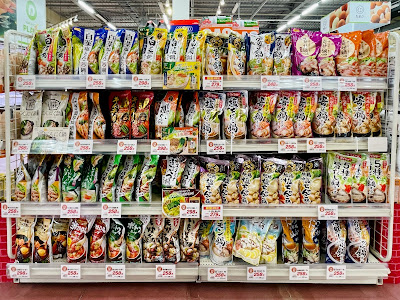We are having shabu-shabu or nabe (nabe literally mean pot) dinner like four times in a week in winter. Shabu-shabu is served with thin slices of meat or fish, which need only a few seconds to cook right before eating. Whereas, nabe is usually prepared with chunky pieces of meat or seafoods and everything is cooked together in the pot. Well, the word "nabe" itself is a general term for both shabu-shabu and nabe. Confusing isn't it?
Nabe is pretty much the same as Chinese hotpot/steamboat except that Japanese hotpot is usually prepared with mostly raw ingredients. It is very easy to prepare with almost all the ingredients are readily available from the shelves in supermarkets. Pick up a pack of the hotpot stock together with some pre-cut meat or seafood and veggies on the way home, no cutting required. All you need is a pot to enjoy a decent homecooked hotpot.
With the dual hotpot, we could have two types of stock to cater for the non-spicy eater. Sichuan spicy stock for adults and the non-spicy Japanese dashi stock for the boys. You can have any stock for your nabe actually, let your imagination run wild.
In the photo, the sweet corn and lotus root were for the Sichuan style hotpot. Common vegetables for nabe are Chinese cabbage, long green onion (Welsh onion), shiitake mushroom, enoki mushroom, and mizuna (mustard green).
I managed to take these photos at a near by supermarket. There is usually a section setup for the hotpot stock and ingredients in winter. So many flavors available now, I have not tried all of them yet.
 |
| Liquid type hotpot stocks. More on the other side of the shelves. |
 |
| Cube type and liquid type nabe stocks. |


Comments
Post a Comment
Thank you for dropping by.
Have a wonderful day ☆彡
(Comment with an ads link will be deleted.)